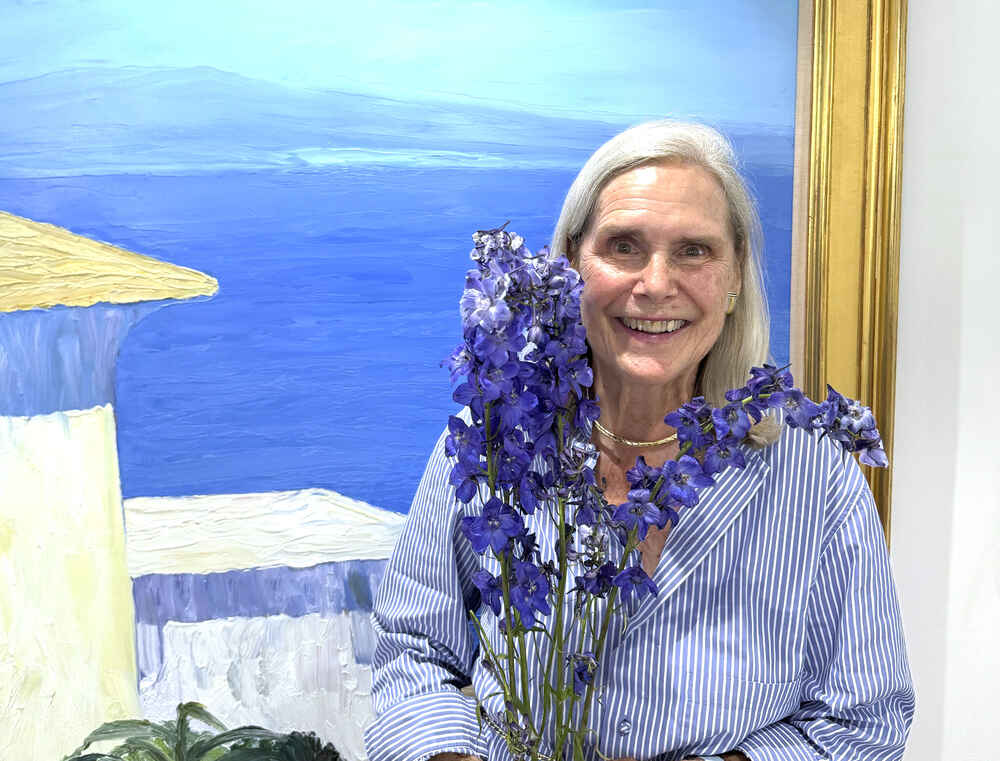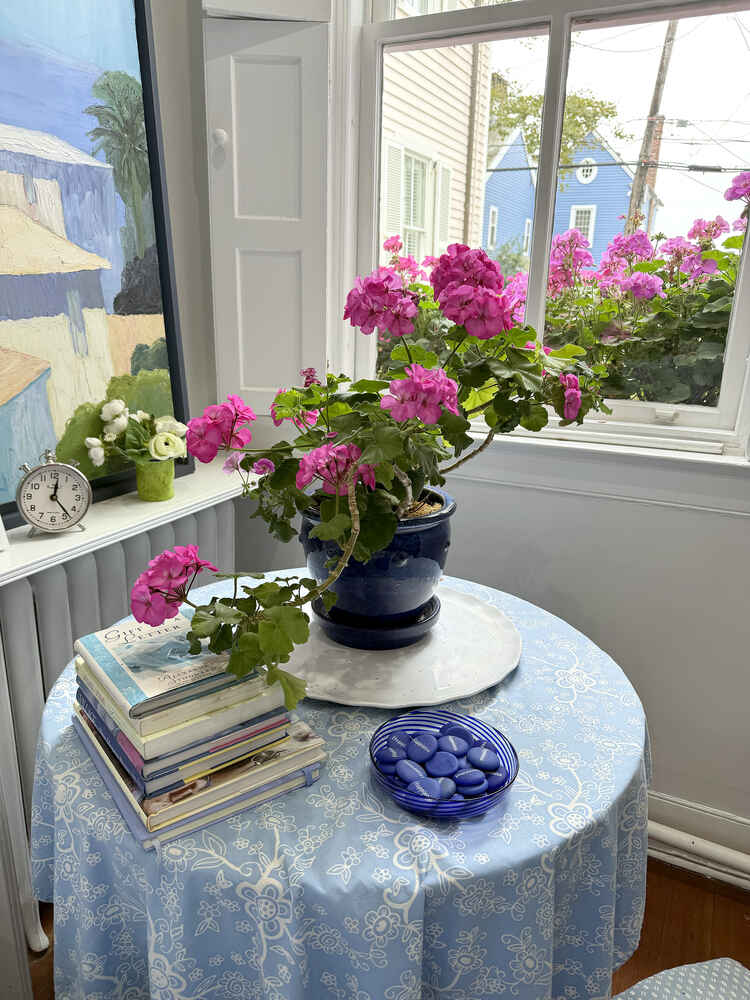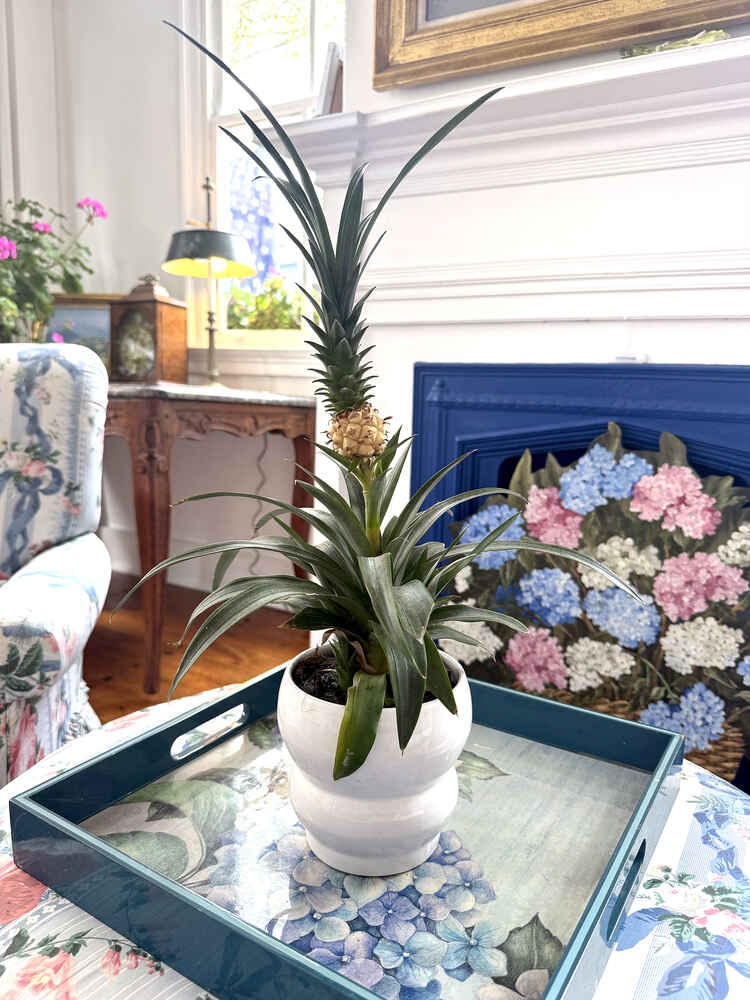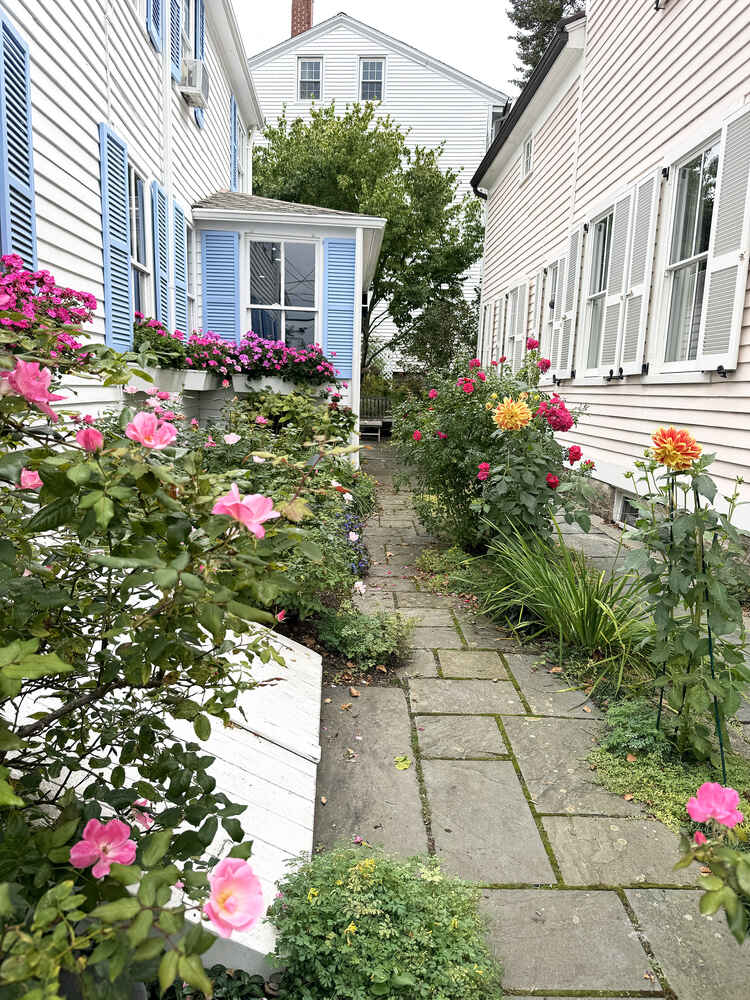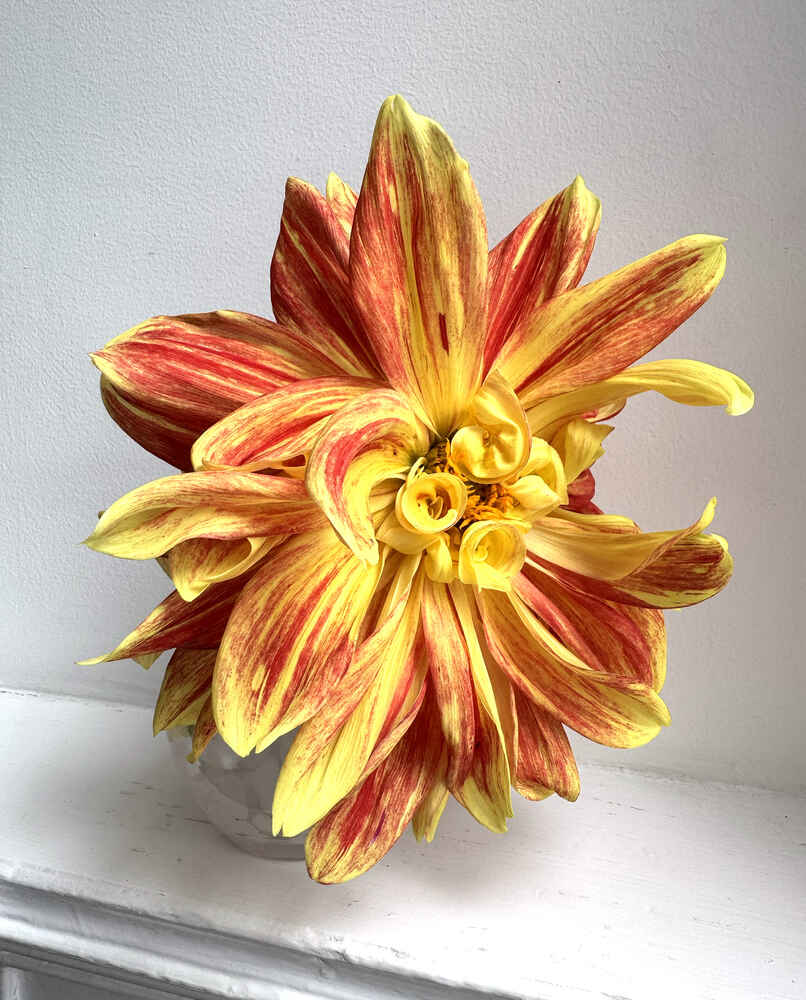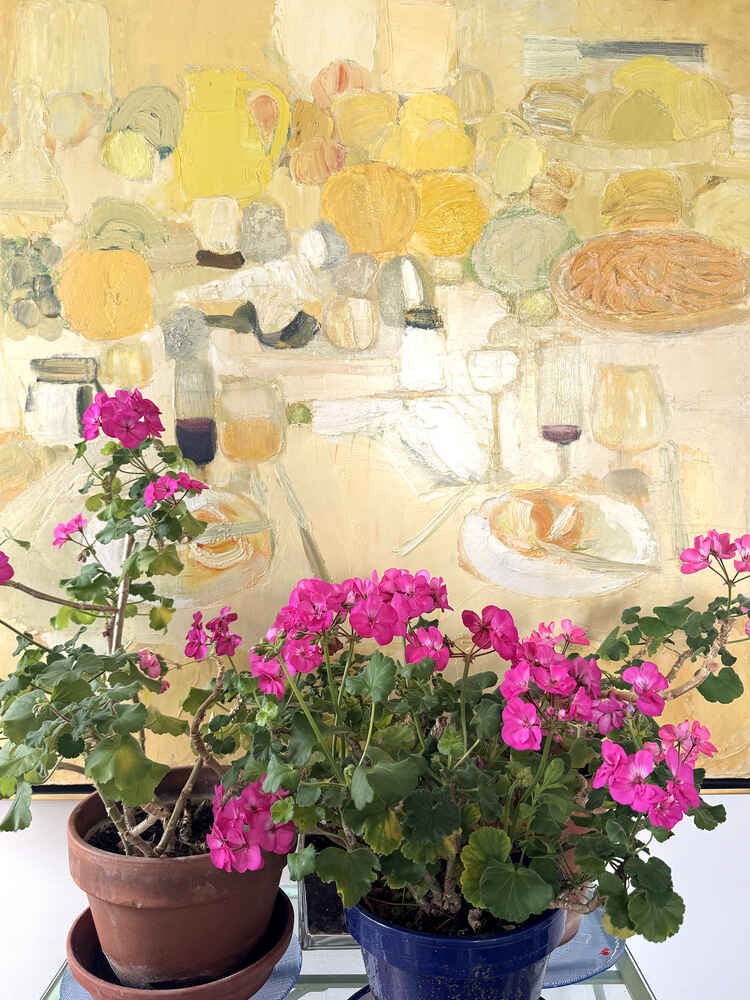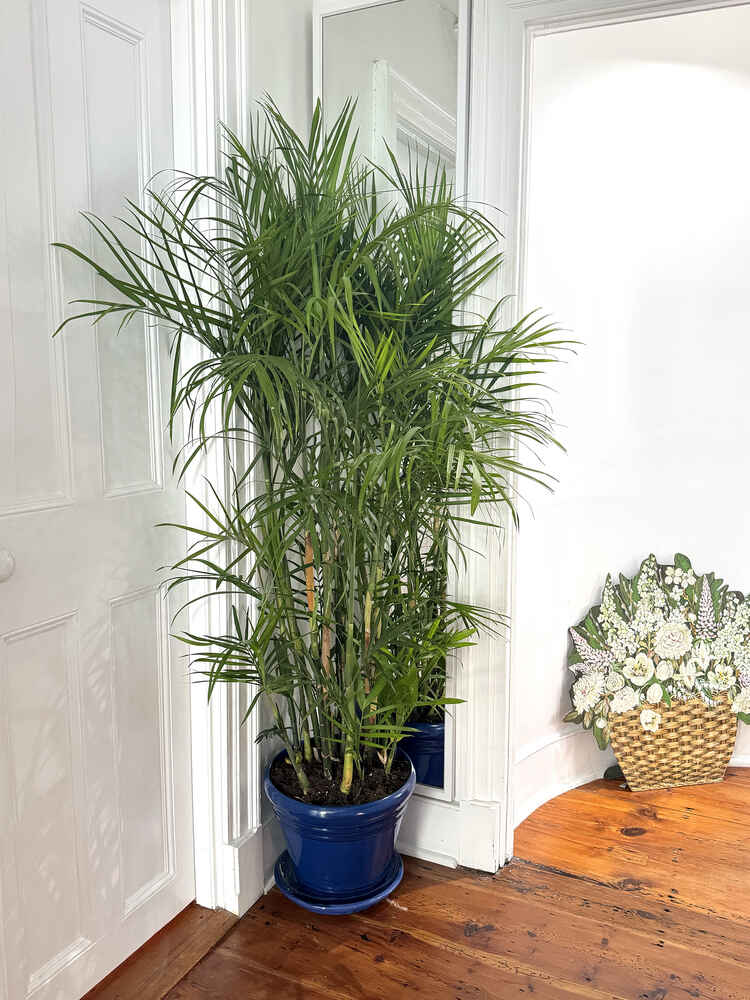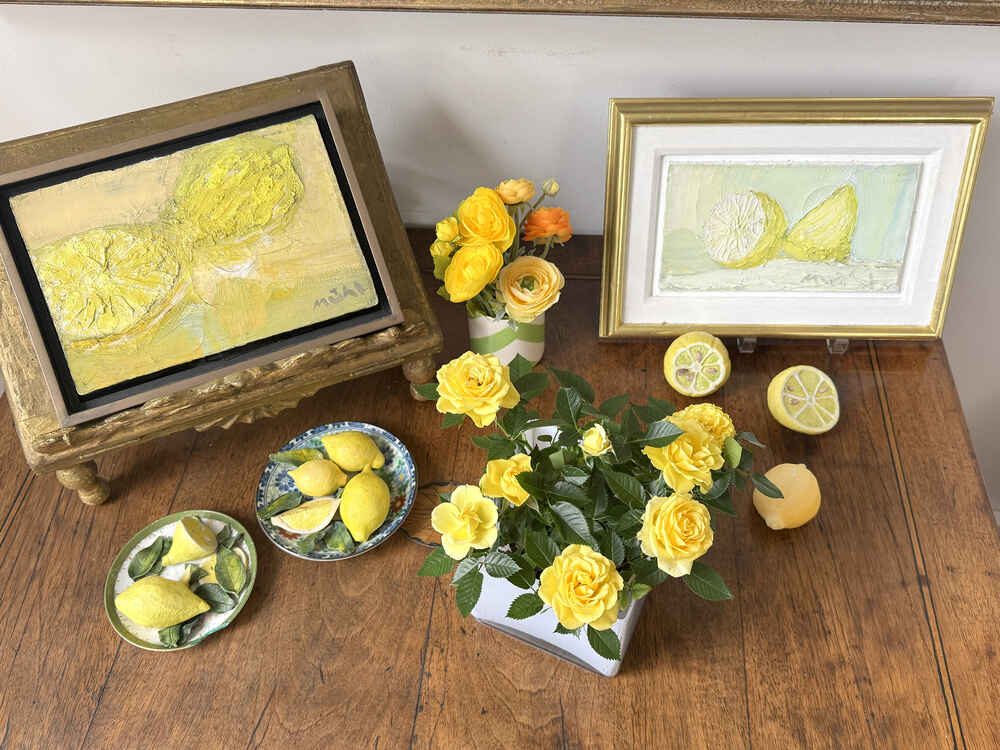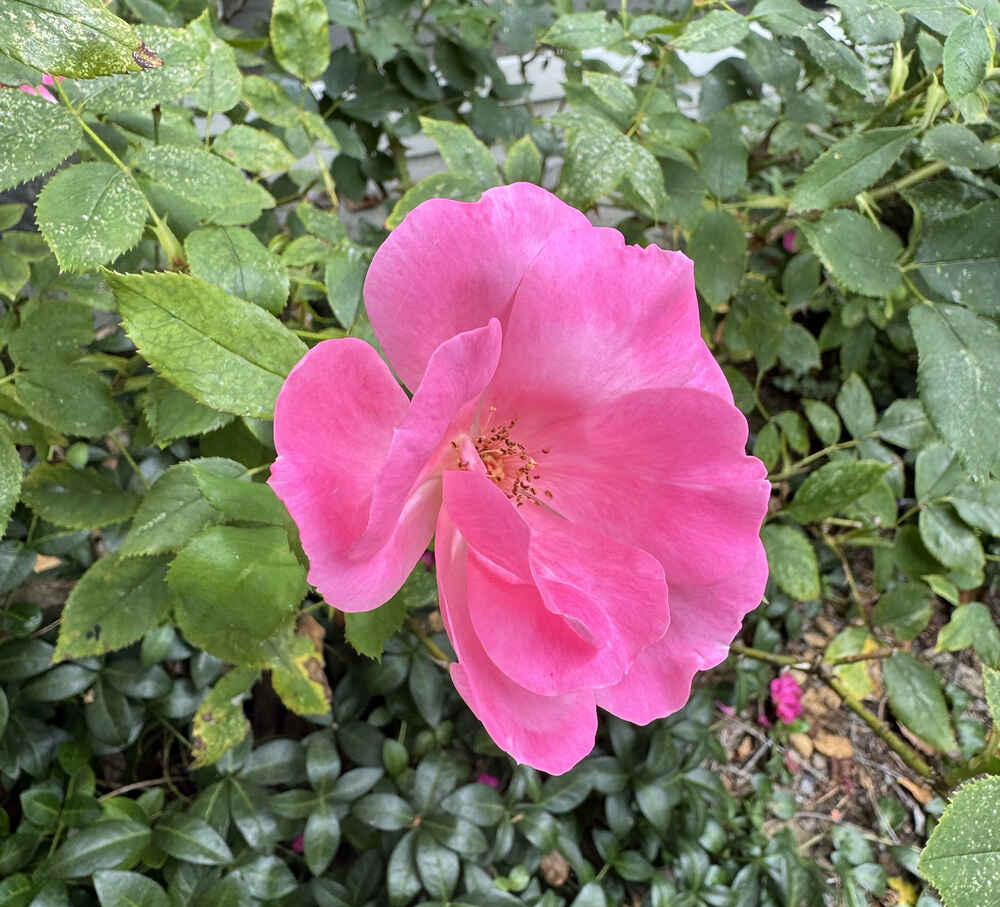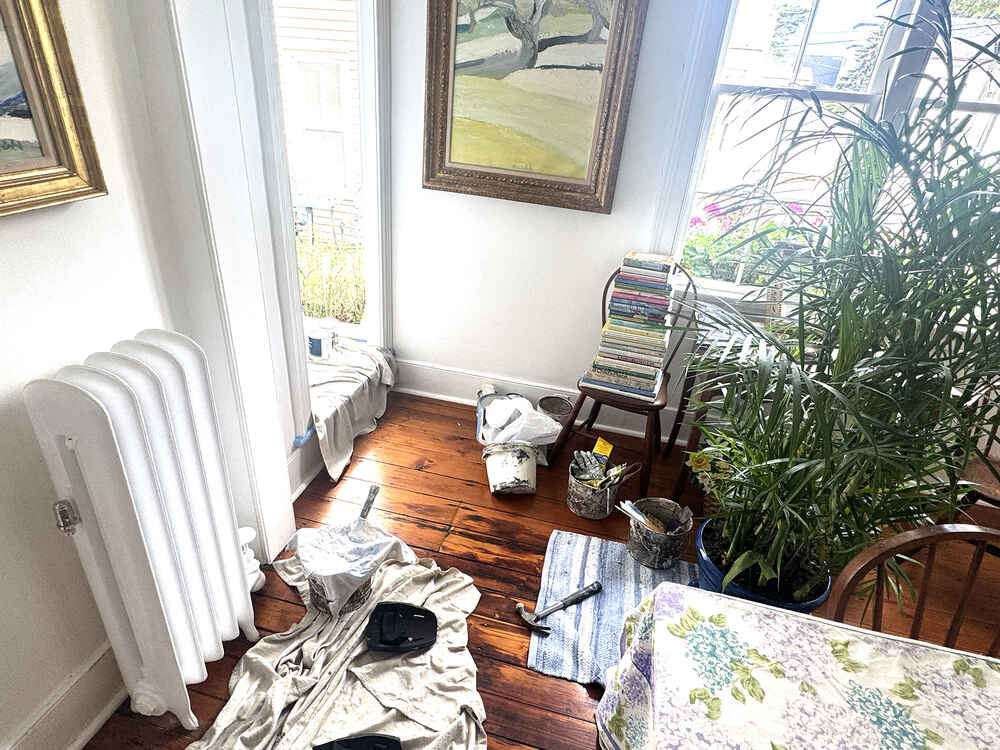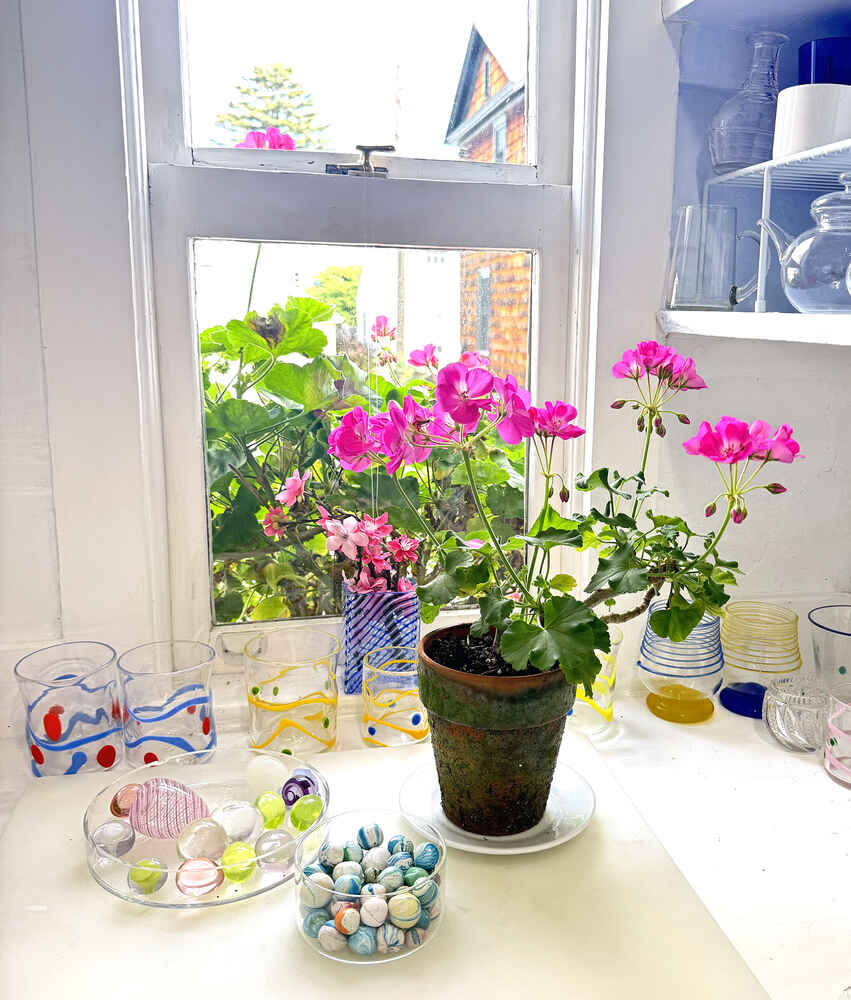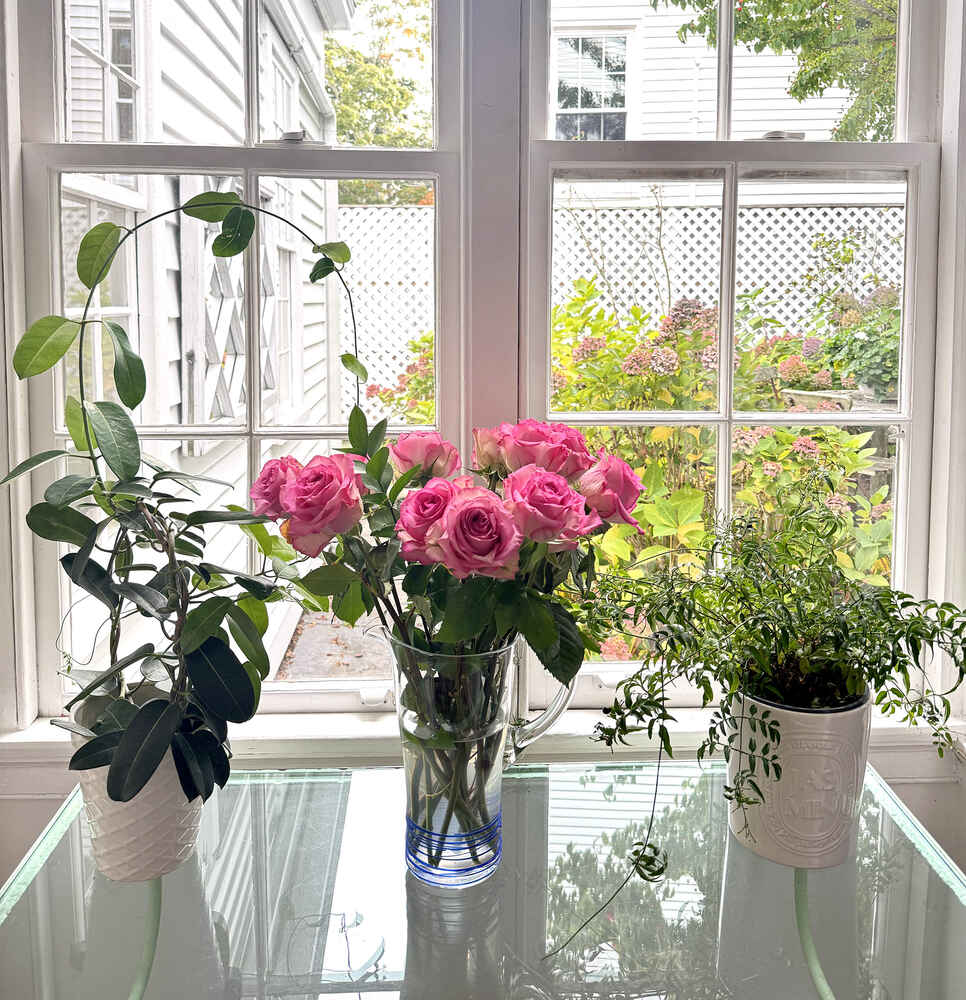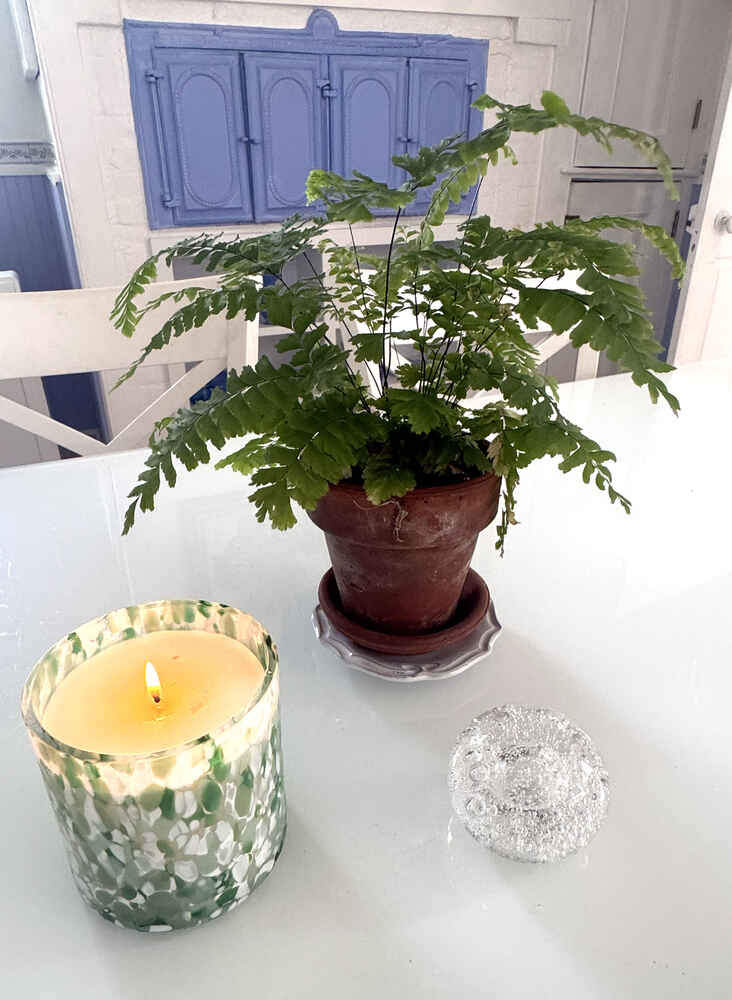AUTHOR | SPEAKER | PHILOSOPHER | DESIGNER
October 2025
Dear Friends,
Happy October! September was a spectacular month.
I told you I’d write about theater that I’ve enjoyed, but I’m going to wait because so many other exciting things occupy my mind. One theater experience that was sensational was My Fair Lady. Carolyn and I went to the opening performance at the Ivoryton Playhouse, and our hearts could have danced all night. Pure delight.
Hillary came to visit from Houston, first stopping in New York to see her brother and go to the U.S. Open with her daughter Tess (named after her grandmother, my best friend!). We talked about everything under the sun, enjoying a huge catch-up. We spent all our waking time out-of-doors, in ideal September weather, at the water’s edge.
My granddaughter Lily also came for a visit, and Alexandra came to help me spruce up the cottage for the house tour on October 11. To celebrate the anniversary of Peter’s death on September 25, 2014, our friend Pauline came for a day visit. She lives in New York and loves to come visit me in Stonington, dreaming of moving here one day.
Difficulties of Aging
I read a fascinating story last month in the New York Times about three Austrian nuns called “The Parable of 3 Nuns and an Escape Plot,” by Christopher F. Schuetze and Jim Tankersley. Sister Bernadette, who is 88, had lived in an abbey in a castle built in the Middle Ages just outside Salzburg since 1955. The abbey had moved into the castle 150 years ago. Bernadette is one of three surviving nuns; the other living sisters are Rita, age 81, and Regina, now 86. In 2022, a new manager took over their convent. Two years ago, the three surviving nuns were told they had to move: a church rule states that orders must have at least six living members. They had to leave, and they were moved against their will.
The nuns were miserable in their new church-run retirement home less than five miles away. It was not their home, where they’d lived for years. For the first time since they’d come to the abbey, they had to eat with men at the retirement place. The sisters badly wanted to go home to the abbey where they had lived, taught and prayed.
In a nearby cemetery, engraved on a wall, are the names of the 32 nuns who had been part of the order of St. Augustine before they died. There were 35 nuns when Sister Bernadette joined the abbey, and she, Rita and Regina want to someday be added to the list of sisters.
An escape plot was spearheaded by a former student, Christina Wirtenberger, who assisted in the secret plan to return the nuns to the abbey. Former students met last October at a class reunion and decided to free their teachers from their unhappiness.
Social media spread the word. On September 4, Wirtenberger arrived in front of the senior center to take the three sisters back to the abbey, along with a moving truck and lots of reporters. The hope was that the news coverage would help change the mind and heart of the abbot.
Fifteen minutes later, a locksmith (hired by a former student of a sister) unlocked the door to their home in the abbey of the church they’d so loyally served. There was no power. No water. The nuns climbed up four flights to get to their rooms. Supporters helped clean and bring the nuns food. Wirtenberger set up a WhatsApp group that currently has 42,000 followers.
Church officials felt helpless amid the media blitz. They were mostly baffled, according to the article. A spokesman admitted that “it’s clear that it’s not easy to leave a place where you’ve lived for decades.”
This simple story is a reminder to all of us that we want to have autonomy about where and how we live, especially at the end of our lives. I was touched by the sisters’ spirit of place and how essential it was to their spirituality and their lives.
I’ve Read ‘Nature and the Mind’
When I wrote “Your Attention Needs a Reset” in last month’s newsletter, I had ordered but not yet read Nature and the Mind. Now I’ve read this magnificent book. In the book, the pioneering founder of environmental neuroscience, Dr. Marc G. Berman, reminds us of nature’s sacred gifts to all sentient beings. I was heartened to hear from so many of you nature lovers (and tree huggers) that you’ve also ordered this important book and find the scientific research so compelling.
Dr. Berman is a professor and the chair of the department of psychology at the University of Chicago. His scholarship shines brilliantly in his passion for nature’s power over our health and overall well-being. Because he is a scientist, he walks the reader through his numerous lab and field experiments. (His notes, bibliography and index are cutting-edge in the thorough research in this new, exciting field of environmental neuroscience.)
Dr. Berman’s provocative book provides a promise that all of us will experience greater contentment when we focus on our interacting more in nature’s extraordinary beauty and grace. When we are out in nature, we can make a deliberate effort to pay close attention to how we feel, what we see, smell, touch, hear and taste. He also urges us to bring nature and natural elements inside our man-made interior dwellings.
We can naturalize our private environments with flowers, plants and trees. We soften the rough edges when we bring nature inside. If the garden is paradise, having nature’s bounty growing in the rooms where you spend so much time is restorative. Both you and the plant world need sunlight and nurturing. As you know, I love to putter around the cottage watering, deadheading and misting my plants, loving them up, admiring their colors, shapes, curving forms and grace. I’ve created a walking meditation in the cottage as I examine how everything is growing.
Sometimes I’ll place the pots in different light exposures to give them a boost. The great advantage of gardening in pots is our ability to move our plants around to give them sufficient light in order for them to thrive. I need plants in the rooms where I spend time because they are alive and create good energy.
After a frost, the hot pink geraniums leave the window boxes for the winter. I bring several hot pink blossoms inside to enjoy and bring cheer to the rooms.
When you’re selecting art and photographs to hang on your bare walls, consider landscapes and seascapes. The depth perception gives us an expansive sense of spaciousness when we look at blue sky and blue water. We look out upon a lovely garden, woods and spacious vistas when we have landscape art and photographs of natural beauty surrounding us in the rooms where we spend a great deal of our waking hours.
The time we spend cultivating our immediate environment as well as spending quality time in real nature out-of-doors benefits our brain health, our productivity and our overall well-being.
Now that I have lived in the cottage since 1988, with water views to the east and west, I know I need to live where I can see the light on the water in daylight, the sunsets on the water and the moon at night. When we know where we want to live and the natural elements that feed our souls, this truth makes us feel at peace. Dr. Berman wants us to have a “nature revolution” in order to be “truly transformative.”
Reading Nature and the Mind reminds us that we’re able to immediately reset our mindfulness when we envelop ourselves in the natural world. I feel such a sense of inner peace whenever I quietly, meditatively meander about, observing nature’s wondrous beauty.
Whenever I look up and see a sunrise, a rainbow, a spectacular sunset, a waterfall or the ocean waves at a beach, I feel a calm balm engulf me. I love opening the back door of the cottage to wander around the tiny garden in the sunlight. Being in a garden becomes a meditation that elevates my thoughts to a higher realm of spiritual reverence for the incomparable beauty.
“Perfect tranquility within consists in the good ordering of the mind, the realm of your own.” —Marcus Aurelius
The Joy of Great Writing
There are times when I am not so concerned about the details of a novel’s story but can so easily can become enchanted by the beauty of the writing. This Is Happiness is about ordinary, good, conscientious people in a small, rain-soaked, rural community in the western seaboard of Ireland in an earlier, simpler age. The acclaimed author Niall Williams’ superb novel-memoir is set in a town, Faha, that could be “Our Town.” With humor and gentle, lilting language, this book is a joyful, delicious treat full of sweet innocence, goodness and truths about the human condition, and Williams’ phrases will linger in your heart.
Williams writes knowledgeably about rain. The first chapter is four words: “It had stopped raining.” The last chapter, 44, his final words: “It had started raining.” Williams also wrote History of the Rain. He knows the rain.
Read This Is Happiness to learn about technology coming to a fictional town that had been unchanged in 1,000 years. Not everyone in town embraces electricity, and it causes quite a stir when they learn that one million electric poles would be installed in the country, made not from Irish wood but imported from Finland’s famous forests. The scope of this mind-altering change is inconceivable to many of the unconverted folks.
An old farmer tends his land from dawn to dusk seven days a week. When a neighbor asks if he ever plans to take a vacation, the old man frowns. (Is this guy crazy?) His glower speaks volumes. He asks his neighbor where he would find his happiness on a vacation. If he wanted to take a vacation, he says, he’d walk over to the fence, go to a meadow, lay down his jacket on the earth, lie down and look at the sky. “This is happiness.”
You’ll enjoy Williams’ sense of humor, his precise choice of words and the idiosyncrasies of each of his character’s stories.
The sun does come out after the rain stops. The town of Faha is bathed in transforming illumination, even when it rains.
“When the Going Was Good”
Remember the good old days of magazines? Graydon Carter’s memoir When the Going Was Good: An Editor’s Adventures During the Last Golden Age of Magazines is 422 pages of gossip and the inside scoop at Vanity Fair and all the writers, editors, photographers and celebrities during the “golden age.”
If you have no interest in Graydon Carter’s world, you will still find this book by an editor, writer, illustrator, world traveler, entertaining storyteller, party host and devoted father a delicious treat to read. It’s because Carter is such a rich storyteller, with hundreds of characters you know about — and his book invites you to dine with them, be in the room with them and learn who’s who and what’s what in the heyday of the pre-internet culture — that you can live the dream vicariously.
Whenever I can’t put a book down, when I’m so engrossed in being amused for the pure pleasure of time standing still, I’m thrilled. Reading a book of this length in a few days’ time cleared my heart and made me grateful to be at the beach, on vacation, with my toes in the Atlantic Ocean, under a shade tent next to my daughter, who was equally enjoying her murder mystery. (She was reading an advance reader copy of the new Thursday Murder Club book by Richard Osman; the books are the inspiration for the new Netflix movie.) Even light page-turners are good for our brains if we become completely absorbed in the subject and can remain focused on the words on each page.
I was living in New York, working as an interior designer, during the decades Carter was the editor of Spy, the New York Observer and Vanity Fair. In one juicy story, Carter writes about how S.I. Newhouse of Condé Nast had lunch with him in 1992 and offered him the job of editor of the New Yorker. Just before it was to be announced to the public, a switcheroo happened, and suddenly Tina Brown was at the New Yorker and he was made editor of Vanity Fair! The book is juicy, irreverent and naughty, and it’s ever so nice to read Carter’s mischievous prose. Being there among the beautiful people virtually is vicariously delicious, a fantasy and illusion we are all fascinated by.
We learn the inside scoop, the backstage drama that was behind the award-winning virtuoso storyteller who was the life of every party and wrote and got writers to write what we enjoyed reading. Now his memoir, written with his longtime friend and former colleague James Fox, vividly details and deeply researches all those glamorous, exciting years in the New York City places where these publishing powerhouses ate and drank, what they wore, who they saw and how they interacted. The writers, editors and photographers were at the scene where the people they wrote about hung out.
Carter’s sharp pen will not be popular with some of the rich, powerful and famous people he trashes. I’m sure he has good lawyers. Read the book to believe my words: the truth is often hidden from the reader. The book doesn’t spare the horses. Carter tells it all, unafraid and unabridged.
When the Going Was Good is a bestseller, a nostalgic window into the excesses of the “golden age.” Carter’s lavish book launch soiree honored a man who was once in charge of “everything.” I reflected on this time frame, this era of money, power and prominence that influenced American thoughts and, to a larger extent than we might have realized at the time, how we lived our lives because of these glossy magazines.
Because I was a New York–based interior designer in this earlier era, in the grand days of magazines, I’m grateful to have relived (not always vicariously) the exciting scenes of this bygone-forever gilded, golden age, often having my design work photographed and published as well as articles written about me.
Michael M. Grynbaum, a New York Times correspondent who covers the media, politics and culture, wrote Empire of the Elite: Inside Condé Nast, the Media Dynasty that Reshaped America, another book on the same topic. The writing styles are different; Carter wrote his memoir in the first person and strongly stated his own opinions. Grynbaum is a journalist and reported the factual account of how Condé Nast and all their magazines were able to dominate this glorious past’s culture. He rarely writes in the first person and moves the story forward chronologically until the time when the internet changed the way most Americans live, how they spend their time and money.
Reality dictates the necessity to embrace the future. Both books are a backward glance into a time of excess and influence that seems now to be ancient history in an entirely new age of high technology. I found both books fun to read and packed with a host of colorful characters.
Reading for Pure Pleasure
Apparently, reading for pleasure has been on a steady decline since my birth. Maggie Astor wrote an article in the New York Times about a report finding that “from 2003 to 2023, the share of Americans who read for pleasure fell 40 percent.” Researchers found the sharp decline “surprising,” because the study included print newspapers, books and magazines as well as those in “electronic or audio form.”
Dr. Jill Sonke co-authored the report that studied how important it is “for our health and well-being” to be engaged in art and culture. She reminds us, “As we’re living in this really complex and really challenging time, we really need to be intentional about the ways in which we support our health.”
Because I am a nonfiction writer, my natural tendency is to read philosophy, essays, biographies, memoirs and history. I’ve recently developed a great fondness for fiction because I’m able to feel an empathetic connection to the characters, who become real to me.
We are never alone when we have a book in our hands. Whenever I spend one-on-one time with an author, I’m aware that there is autobiographical information in fiction, and the subjects the writer chooses to write about tend to be of personal interest and meaning.
Astor writes that “Research indicates that reading can have a wide range of benefits for educational attainment, reasoning and comprehension skills, imagination, empathy, mental health, cognitive health and more.”
I tend to ask my friends, “What are you reading?” I’m horrified whenever I hear they’re not reading anything. Because of all the reasons we’re familiar with, we always have excuses for why we can’t seem to find time to read, not even something light. Part of the fun of beginning a novel, for example, is not having any idea how we’re going to react to the story. We’re on a mysterious adventure, and it is a puzzle how it ends up.
Time management is a skill we learn by being brutally honest with ourselves about how we literally spend our time. As I wrote in my letter last month, time and attention are our most treasured possessions. We need to be reminded that reading is a most pleasurable experience, especially when we’re in good company. No one is time bankrupt. The way to find time to read is by making our well-being a priority. Regularly take the necessary time to improve your life by being an avid reader.
I’m aware I’m on a soapbox, but for a reason. Our life span is so short, no matter how fortunate we are to live into old, old age. Reading expands our horizons, enlarges our sense of curiosity about humanity and takes us into other people’s worlds. There’s something extremely healthy about losing ourselves in a good book. Reading for pleasure is just that. Trust yourself. Feel the delight.
Happy autumn! Enjoy the pleasures of spending time observing all the trees in spectacular transformation. Every season has its special beauty. The romantic poet Robert Browning poignantly wrote, “days decrease, / And autumn grows, autumn in everything.”
Thank you for your thoughtful correspondence, book suggestions and questions I am pondering — to be continued.
Love & Live Happy,

This month, I'm letting go of a lithograph by Roger Mühl if anyone is interested in adding it to their art collection. Please contact Pauline at Artioli Findlay (pf@artiolifindlay.com) for more information.
Roger Mühl (French, 1929 - 2008)
Provence X Devant le jardin
Limited edition French lithograph
16 3/4 x 12 1/2 in
The image is printed to the edge of the sheet of paper.
Edition #VII of XX
Executed / printed 1986
Brilliant South of France sunlight is the focus of this lovely rooftop landscape in front of a garden.

